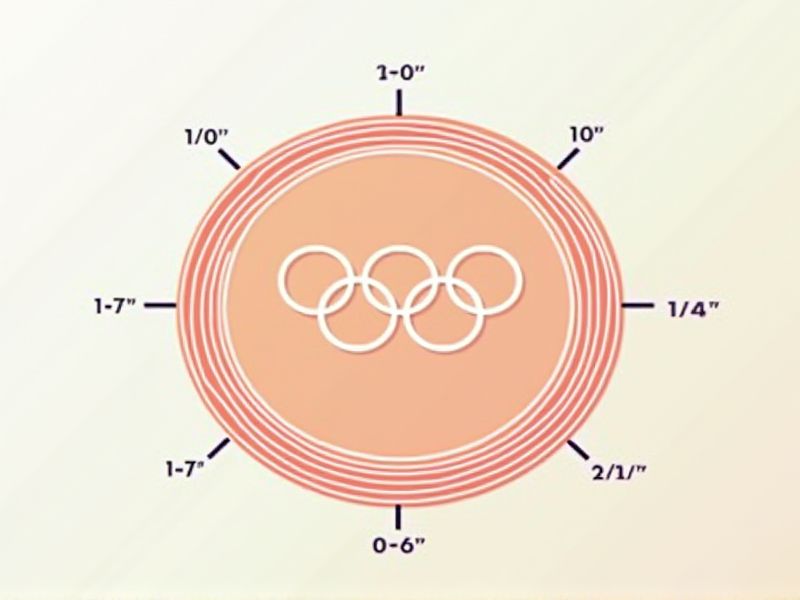
The standard dimensions of an Olympic running track are carefully regulated for fairness and consistency. A typical Olympic track measures 400 meters in length for one lap along the innermost lane. The track itself is oval-shaped, featuring two parallel straight sections each measuring 84.39 meters and two semicircular ends with a radius of 36.5 meters each. With eight lanes, each lane is 1.22 meters wide, giving athletes enough space to run safely and comfortably during races.
400 Meters In Length
The standard Olympic track measures 400 meters in circumference, making it ideal for various events such as sprints and relays. Comprised of eight lanes, a typical track allows for competitive racing while maintaining the integrity of the events. The surface is usually made from synthetic materials, ensuring optimal performance and safety for athletes. During the Olympics, athletes compete not only for personal bests but also for the chance to bring home one of the coveted medals.
Oval Shape
The standard Olympic track features a precise oval shape, measuring 400 meters in circumference. This design allows athletes to maintain optimal speed and performance during races. Comprised of two straight sections and two curved segments, the track's layout is meticulously engineered to facilitate competitive racing across various distances. Ensuring compliance with International Association of Athletics Federations (IAAF) regulations, each lane is typically 1.22 meters wide, allowing for safe and efficient racing conditions.
8 To 9 Lanes
Olympic-standard track facilities typically feature 8 to 9 lanes, with each lane measuring 1.22 meters wide. This configuration allows athletes to compete under optimal conditions, minimizing interference from neighboring competitors. The overall track length is standardized at 400 meters, ensuring consistency across international events. Maintaining these dimensions is crucial for meeting the guidelines set by the World Athletics organization, promoting fairness and safety in elite competitions.
1.22 Meters Wide Lanes
The standard width for Olympic track lanes is 1.22 meters, ensuring ample space for sprinting athletes to perform at their best. Each of the eight lanes is marked to provide clear boundaries, facilitating competitive races. Tracks are typically made from synthetic surfaces designed for optimal grip and speed, enhancing the overall performance of athletes. Understanding these specifications can help you appreciate the precision and engineering that support world-class competitions.
Inner Lane Increases Curve Swing
The standard for Olympic track and field events emphasizes the inner lane's design, which plays a crucial role in optimizing athletes' performance. Specifically, the inner lane enhances curve swing, allowing runners to maintain higher speeds while navigating turns. Research indicates that athletes in the inner lane can potentially save up to 1.5 seconds over 400 meters due to reduced distance traveled on the curves. This strategic advantage highlights the importance of lane assignment in competitive racing scenarios.
Inner Edge Raised Curb
The standard for Olympic tracks includes specifications for an inner edge raised curb, which is essential for defining the competition area and enhancing athlete safety. This curb typically has a height of 0.10 meters and a width of 0.05 meters, ensuring that runners can maintain optimal lanes during races. Proper installation of this curb helps prevent athletes from inadvertently stepping out of their designated paths, thus minimizing the risk of injuries. You might find that many tracks designed to meet these standards utilize durable materials, ensuring longevity and consistent performance over time.
Made Of Synthetic Materials
The standards for Olympic track surfaces emphasize the use of synthetic materials, which include polyurethane and rubber compounds for optimal performance and safety. These surfaces are designed to provide a uniform texture, crucial for athlete traction and reducing injury risk, while also improving overall running speed. In Olympic competitions, the track must meet specific criteria, including a measured length of 400 meters and a minimum durability of 10 years under various weather conditions. Consequently, your training or competitive experience on such tracks can significantly enhance your performance, thanks to their advanced technology and design.
36.5 Meters Radius For Curves
The standard radius for curves in Olympic track design is set at 36.5 meters, ensuring optimal athletic performance and safety. This specification allows for a smooth transition between straight and curved sections, facilitating faster speeds and reducing the potential for injuries. The layout contributes to the overall dynamics of the track, enabling athletes to maintain their momentum throughout the race. Understanding these dimensions is crucial for those involved in track construction and event planning, enhancing the experience for both competitors and spectators.
Two Straights And Curves
The standard Olympic track comprises eight lanes and spans 400 meters, featuring two straight sections followed by two curves. Each straight portion typically measures 84.39 meters, while the curved sections are designed to facilitate a smooth transition, with a radius of 36.5 meters. This layout ensures optimal performance and safety for athletes, enabling them to achieve their best times during competitive events. You can find this track design not only in Olympic venues but also in various international athletics competitions worldwide.
Uniform Slope For Drainage
The Olympic track standard mandates a uniform slope of 1% for optimal drainage to prevent water accumulation during events. This precise gradient ensures the safety and performance of athletes by minimizing wet conditions, thereby enhancing grip and reducing injury risk. Tracks are typically constructed with high-quality materials, such as polyurethane, which provide durability and elasticity, conforming to international regulations. Your track's drainage system must maintain this slope to meet Olympic standards, ensuring excellence in competitive scenarios.
